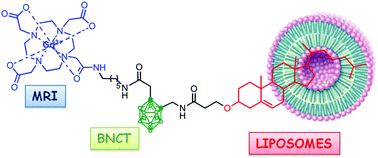Synthesis of a carborane-containing cholesterol derivative and evaluation as a potential dual agent for MRI/BNCT applications†
Abstract
In this study the synthesis and characterization of a new dual, imaging and therapeutic, agent is proposed with the aim of improving the efficacy of Boron Neutron Capture Therapy (BNCT) in cancer treatment. The agent (Gd-B-AC01) consists of a carborane unit (ten boron atoms) bearing a cholesterol unit on one side (to pursue the incorporation into the liposome bi-layer) and a Gd(III)/1,4,7,10-tetraazacyclododecane monoamide complex on the other side (as a MRI reporter to attain the quantification of the B/Gd concentration). In order to endow the BNCT agent with specific delivery properties, the liposome embedded with the MRI/BNCT dual probes has been functionalized with a pegylated phospholipid containing a folic acid residue at the end of the PEG chain. The vector allows the binding of the liposome to folate receptors that are overexpressed in many tumor types, and in particular, in human ovarian cancer cells (IGROV-1). An in vitro test on IGROV-1 cells demonstrated that Gd-B-AC01 loaded liposomes are efficient carriers for the delivery of the MRI/BNCT probes to the tumor cells. Finally, the BNCT treatment of IGROV-1 cells showed that the number of surviving cells was markedly smaller when the cells were irradiated after internalization of the folate-targeted GdB10-AC01/liposomes.


 Please wait while we load your content...
Please wait while we load your content...